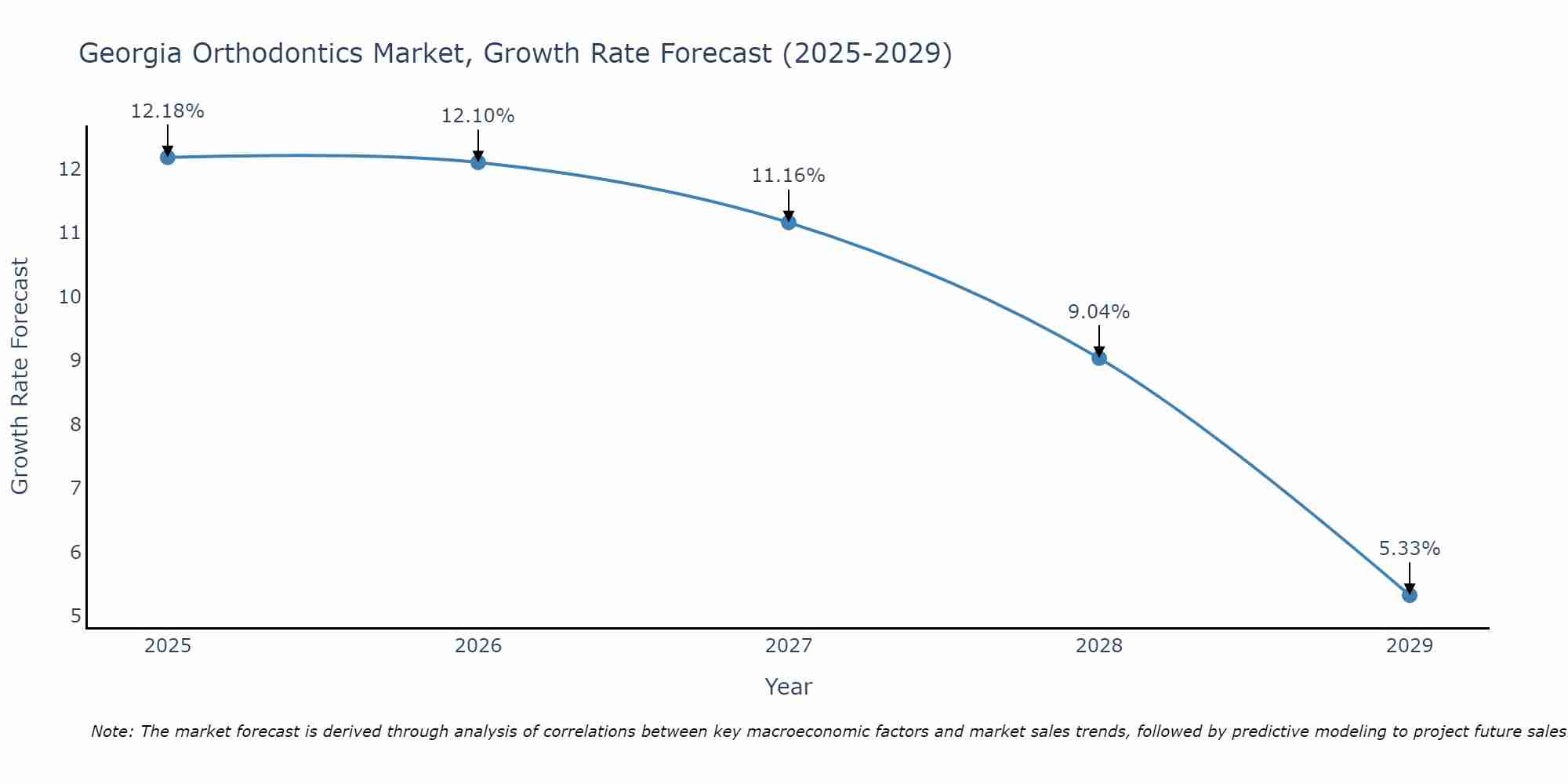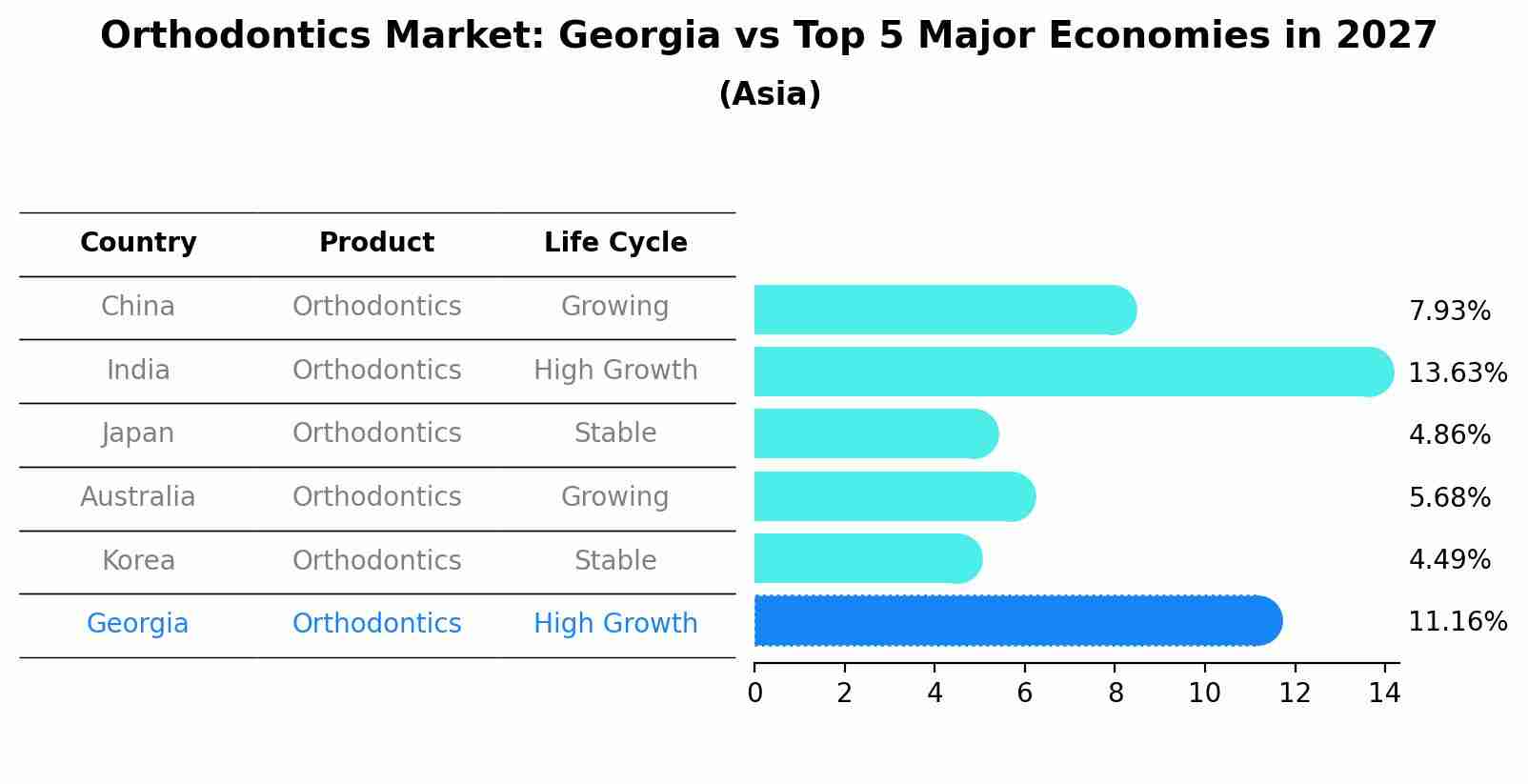Georgia Orthodontics Market Outlook | Growth, Size, Companies, Share, Analysis, Trends, COVID-19 IMPACT, Value, Forecast, Revenue & Industry
| Product Code: ETC426476 | Publication Date: Oct 2022 | Updated Date: Aug 2025 | Product Type: Market Research Report | |
| Publisher: 6Wresearch | Author: Bhawna Singh | No. of Pages: 75 | No. of Figures: 35 | No. of Tables: 20 |
Georgia Orthodontics Market Size Growth Rate
The Georgia Orthodontics Market could see a tapering of growth rates over 2025 to 2029. Although the growth rate starts strong at 12.18% in 2025, it steadily loses momentum, ending at 5.33% by 2029.

Orthodontics Market: Georgia vs Top 5 Major Economies in 2027 (Asia)
The Orthodontics market in Georgia is projected to grow at a high growth rate of 11.16% by 2027, highlighting the country's increasing focus on advanced technologies within the Asia region, where China holds the dominant position, followed closely by India, Japan, Australia and South Korea, shaping overall regional demand.

Georgia Orthodontics Market Synopsis
The Georgia orthodontics market is a rapidly growing sector within the healthcare industry, driven by increasing awareness of the benefits of orthodontic treatments and a growing emphasis on dental aesthetics. With a strong economy and a high percentage of the population covered by dental insurance, the market is experiencing steady demand for orthodontic services. Key players in the market include established orthodontic practices, dental clinics, and orthodontic suppliers. Advances in technology, such as clear aligners and digital imaging, are also contributing to the market`s growth by offering patients more options for treatment. The market is competitive, with providers focusing on offering personalized treatment plans, excellent patient care, and innovative solutions to meet the diverse needs of their clients.
Georgia Orthodontics Market Trends
The Georgia orthodontics market is witnessing several key trends. One prominent trend is the increasing demand for clear aligner treatments, driven by the desire for more discreet orthodontic solutions. Providers in Georgia are also adopting advanced technologies such as 3D imaging and digital scanning to enhance treatment planning and patient experience. Another notable trend is the rise of teleorthodontics, allowing for remote consultations and monitoring, which has become more popular due to the convenience it offers to patients. Additionally, there is a growing focus on personalized treatment plans and patient-centered care, with orthodontic practices in Georgia emphasizing individualized approaches to meet the unique needs and preferences of each patient. Overall, these trends are shaping the orthodontics market in Georgia towards more innovative and patient-centric practices.
Georgia Orthodontics Market Challenges
In the Georgia orthodontics market, one major challenge is the increasing competition among orthodontic practices, leading to price wars and pressure on profit margins. With a growing number of orthodontists in the market, attracting and retaining patients has become more challenging, requiring practices to differentiate themselves through innovative services or marketing strategies. Additionally, the rising costs of operating a practice, including rent, equipment, and staffing, put financial strain on smaller practices. Another challenge is the need to stay updated with technological advancements in orthodontic treatments, which require significant investments in training and equipment. Finally, the regulatory environment and insurance complexities add another layer of challenge for orthodontists in Georgia, requiring them to navigate complex billing processes and compliance requirements while providing quality care to their patients.
Georgia Orthodontics Market Investment Opportunities
The Georgia orthodontics market presents several investment opportunities due to factors such as a growing population with increasing awareness and demand for dental aesthetics, technological advancements in orthodontic treatments, and a relatively high disposable income in the state. Investors could consider opportunities in setting up new orthodontic clinics, partnering with existing practices for expansion, or investing in orthodontic technology companies offering innovative solutions. Additionally, there is potential for investment in specialized orthodontic training programs to cater to the increasing demand for skilled orthodontic professionals in Georgia. Overall, the Georgia orthodontics market offers a promising landscape for investors looking to capitalize on the rising trend of orthodontic treatments and services in the state.
Jordan Agar Market Government Policies
The Georgia orthodontics market is subject to various government policies and regulations that impact the industry. These policies primarily focus on licensing requirements, quality standards, and pricing regulations to ensure patient safety and fair competition among providers. The Georgia Composite Medical Board oversees the licensing and regulation of orthodontists in the state, setting standards for education, training, and ethical practices. Additionally, insurance regulations play a significant role in determining coverage for orthodontic treatments, influencing pricing and accessibility for patients. Overall, government policies in Georgia aim to uphold high-quality standards in orthodontic care while also promoting affordability and transparency in the market.
Georgia Orthodontics Market Future Outlook
The Georgia Orthodontics Market is poised for steady growth in the coming years, fueled by factors such as increasing awareness about the importance of dental health, rising disposable incomes, and advancements in orthodontic technology. With a growing population and a greater emphasis on aesthetics, more individuals are seeking orthodontic treatments to enhance their smiles. Additionally, the availability of various treatment options, such as clear aligners and lingual braces, is expected to drive market expansion. As the demand for orthodontic services continues to rise, orthodontic practices in Georgia have the opportunity to expand their patient base and enhance their offerings to cater to evolving consumer preferences and needs. Overall, the outlook for the Georgia Orthodontics Market appears promising, with opportunities for growth and innovation on the horizon.
Key Highlights of the Report:
- Georgia Orthodontics Market Outlook
- Market Size of Georgia Orthodontics Market, 2021
- Forecast of Georgia Orthodontics Market, 2031
- Historical Data and Forecast of Georgia Orthodontics Revenues & Volume for the Period 2018 - 2031
- Georgia Orthodontics Market Trend Evolution
- Georgia Orthodontics Market Drivers and Challenges
- Georgia Orthodontics Price Trends
- Georgia Orthodontics Porter's Five Forces
- Georgia Orthodontics Industry Life Cycle
- Historical Data and Forecast of Georgia Orthodontics Market Revenues & Volume By Product Type for the Period 2018 - 2031
- Historical Data and Forecast of Georgia Orthodontics Market Revenues & Volume By Instruments for the Period 2018 - 2031
- Historical Data and Forecast of Georgia Orthodontics Market Revenues & Volume By Supplies for the Period 2018 - 2031
- Georgia Orthodontics Import Export Trade Statistics
- Market Opportunity Assessment By Product Type
- Georgia Orthodontics Top Companies Market Share
- Georgia Orthodontics Competitive Benchmarking By Technical and Operational Parameters
- Georgia Orthodontics Company Profiles
- Georgia Orthodontics Key Strategic Recommendations
Frequently Asked Questions About the Market Study (FAQs):
1 Executive Summary |
2 Introduction |
2.1 Key Highlights of the Report |
2.2 Report Description |
2.3 Market Scope & Segmentation |
2.4 Research Methodology |
2.5 Assumptions |
3 Georgia Orthodontics Market Overview |
3.1 Georgia Country Macro Economic Indicators |
3.2 Georgia Orthodontics Market Revenues & Volume, 2021 & 2031F |
3.3 Georgia Orthodontics Market - Industry Life Cycle |
3.4 Georgia Orthodontics Market - Porter's Five Forces |
3.5 Georgia Orthodontics Market Revenues & Volume Share, By Product Type, 2021 & 2031F |
4 Georgia Orthodontics Market Dynamics |
4.1 Impact Analysis |
4.2 Market Drivers |
4.2.1 Increasing awareness about the importance of dental health and aesthetics |
4.2.2 Technological advancements in orthodontic treatments |
4.2.3 Growing disposable income leading to higher spending on dental care |
4.3 Market Restraints |
4.3.1 High costs associated with orthodontic treatments |
4.3.2 Limited insurance coverage for orthodontic procedures |
4.3.3 Shortage of skilled orthodontic professionals in the market |
5 Georgia Orthodontics Market Trends |
6 Georgia Orthodontics Market, By Types |
6.1 Georgia Orthodontics Market, By Product Type |
6.1.1 Overview and Analysis |
6.1.2 Georgia Orthodontics Market Revenues & Volume, By Product Type, 2021-2031F |
6.1.3 Georgia Orthodontics Market Revenues & Volume, By Instruments, 2021-2031F |
6.1.4 Georgia Orthodontics Market Revenues & Volume, By Supplies, 2021-2031F |
7 Georgia Orthodontics Market Import-Export Trade Statistics |
7.1 Georgia Orthodontics Market Export to Major Countries |
7.2 Georgia Orthodontics Market Imports from Major Countries |
8 Georgia Orthodontics Market Key Performance Indicators |
8.1 Average number of orthodontic procedures per capita in Georgia |
8.2 Number of orthodontic clinics opening in the region |
8.3 Patient satisfaction rates with orthodontic treatments |
8.4 Adoption rate of new orthodontic technologies |
8.5 Average waiting time for orthodontic appointments |
9 Georgia Orthodontics Market - Opportunity Assessment |
9.1 Georgia Orthodontics Market Opportunity Assessment, By Product Type, 2021 & 2031F |
10 Georgia Orthodontics Market - Competitive Landscape |
10.1 Georgia Orthodontics Market Revenue Share, By Companies, 2021 |
10.2 Georgia Orthodontics Market Competitive Benchmarking, By Operating and Technical Parameters |
11 Company Profiles |
12 Recommendations |
13 Disclaimer |
- Single User License$ 1,995
- Department License$ 2,400
- Site License$ 3,120
- Global License$ 3,795
Search
Thought Leadership and Analyst Meet
Our Clients
Related Reports
- Canada Oil and Gas Market (2026-2032) | Share, Segmentation, Value, Industry, Trends, Forecast, Analysis, Size & Revenue, Growth, Competitive Landscape, Outlook, Companies
- Germany Breakfast Food Market (2026-2032) | Industry, Share, Growth, Size, Companies, Value, Analysis, Revenue, Trends, Forecast & Outlook
- Australia Briquette Market (2025-2031) | Growth, Size, Revenue, Forecast, Analysis, Trends, Value, Share, Industry & Companies
- Vietnam System Integrator Market (2025-2031) | Size, Companies, Analysis, Industry, Value, Forecast, Growth, Trends, Revenue & Share
- ASEAN and Thailand Brain Health Supplements Market (2025-2031) | Strategy, Consumer Insights, Analysis, Investment Trends, Opportunities, Growth, Size, Share, Industry, Revenue, Segments, Value, Segmentation, Supply, Forecast, Restraints, Outlook, Competition, Drivers, Trends, Demand, Pricing Analysis, Competitive, Strategic Insights, Companies, Challenges
- ASEAN Bearings Market (2025-2031) | Strategy, Consumer Insights, Analysis, Investment Trends, Opportunities, Growth, Size, Share, Industry, Revenue, Segments, Value, Segmentation, Supply, Forecast, Restraints, Outlook, Competition, Drivers, Trends, Demand, Pricing Analysis, Competitive, Strategic Insights, Companies, Challenges
- Europe Flooring Market (2025-2031) | Outlook, Share, Industry, Trends, Forecast, Companies, Revenue, Size, Analysis, Growth & Value
- Saudi Arabia Manlift Market (2025-2031) | Outlook, Size, Growth, Trends, Companies, Industry, Revenue, Value, Share, Forecast & Analysis
- Uganda Excavator, Crane, and Wheel Loaders Market (2025-2031) | Strategy, Consumer Insights, Analysis, Investment Trends, Opportunities, Growth, Size, Share, Industry, Revenue, Segments, Value, Segmentation, Supply, Forecast, Restraints, Outlook, Competition, Drivers, Trends, Demand, Pricing Analysis, Competitive, Strategic Insights, Companies, Challenges
- Rwanda Excavator, Crane, and Wheel Loaders Market (2025-2031) | Strategy, Consumer Insights, Analysis, Investment Trends, Opportunities, Growth, Size, Share, Industry, Revenue, Segments, Value, Segmentation, Supply, Forecast, Restraints, Outlook, Competition, Drivers, Trends, Demand, Pricing Analysis, Competitive, Strategic Insights, Companies, Challenges
Industry Events and Analyst Meet
Whitepaper
- Middle East & Africa Commercial Security Market Click here to view more.
- Middle East & Africa Fire Safety Systems & Equipment Market Click here to view more.
- GCC Drone Market Click here to view more.
- Middle East Lighting Fixture Market Click here to view more.
- GCC Physical & Perimeter Security Market Click here to view more.
6WResearch In News
- Doha a strategic location for EV manufacturing hub: IPA Qatar
- Demand for luxury TVs surging in the GCC, says Samsung
- Empowering Growth: The Thriving Journey of Bangladesh’s Cable Industry
- Demand for luxury TVs surging in the GCC, says Samsung
- Video call with a traditional healer? Once unthinkable, it’s now common in South Africa
- Intelligent Buildings To Smooth GCC’s Path To Net Zero


















